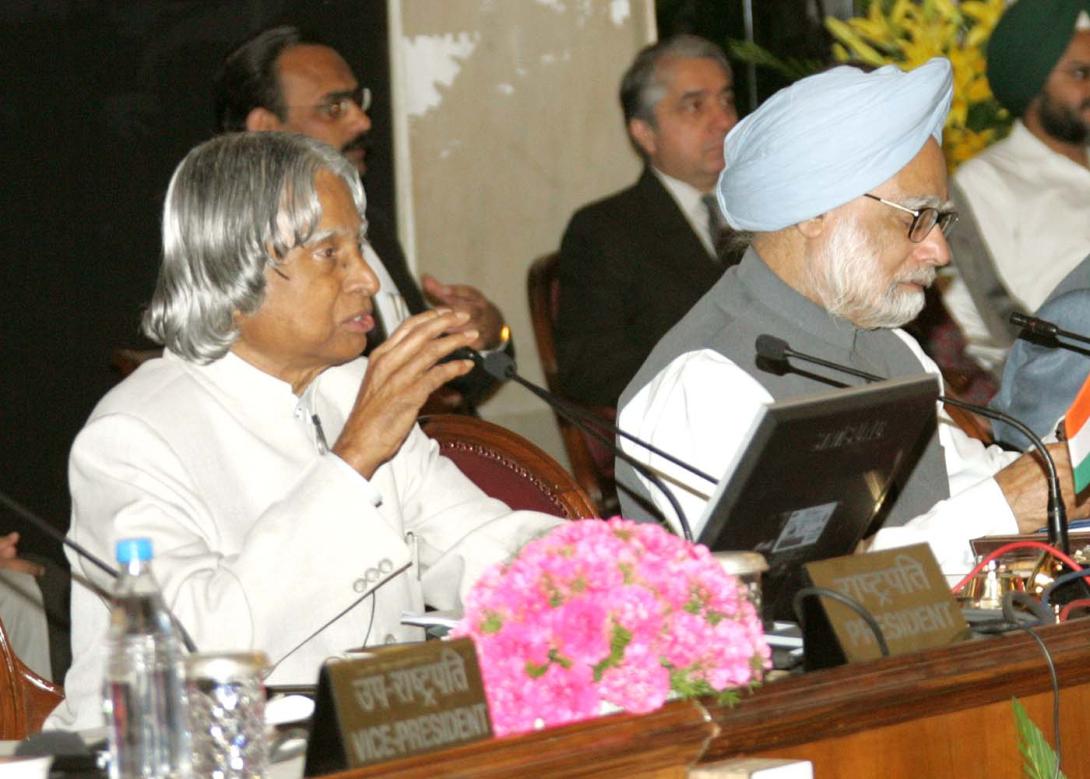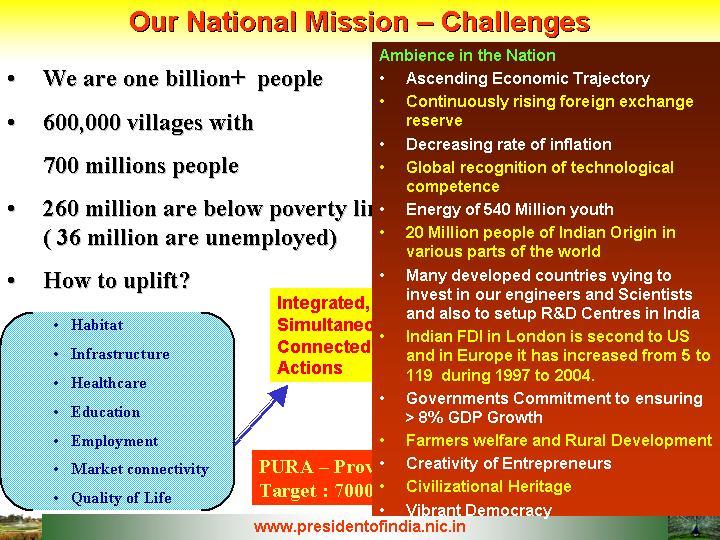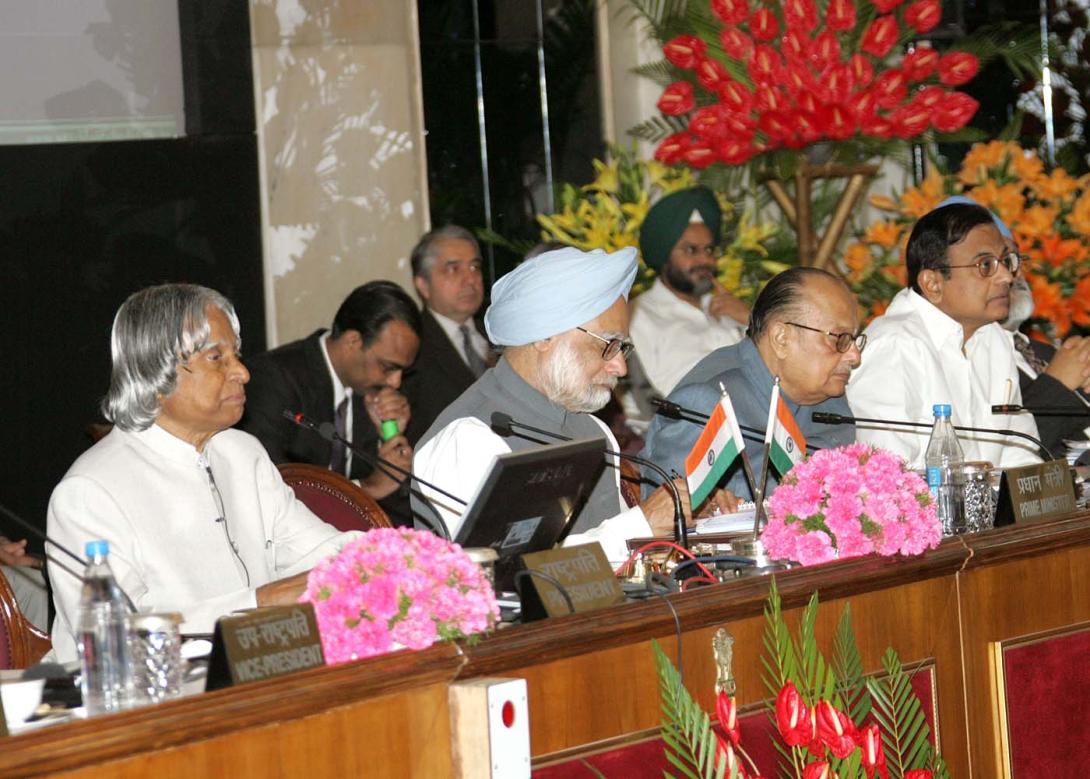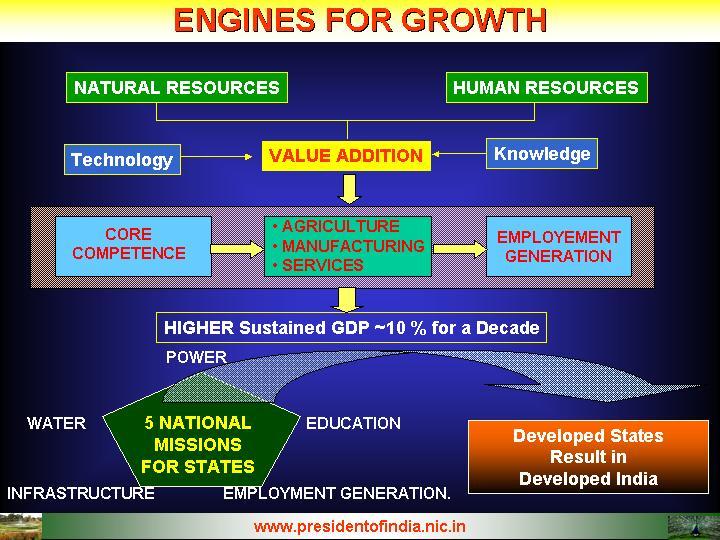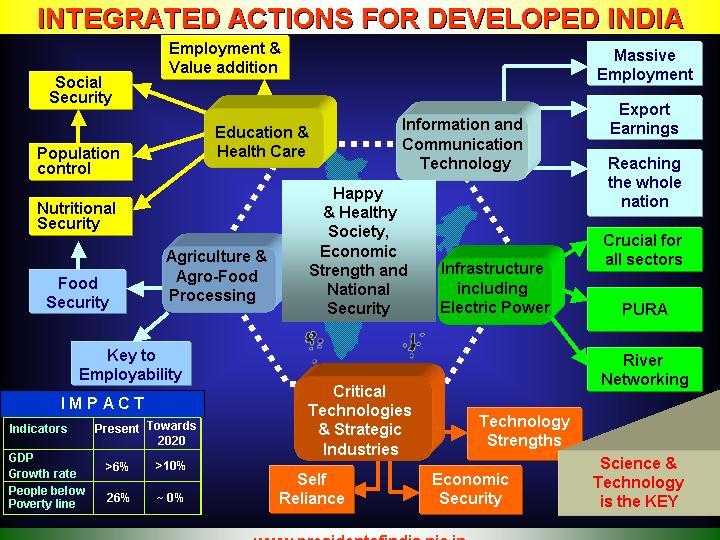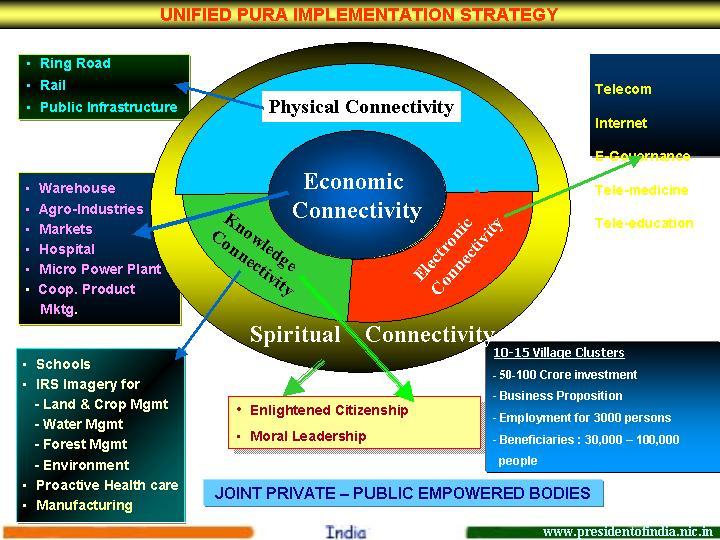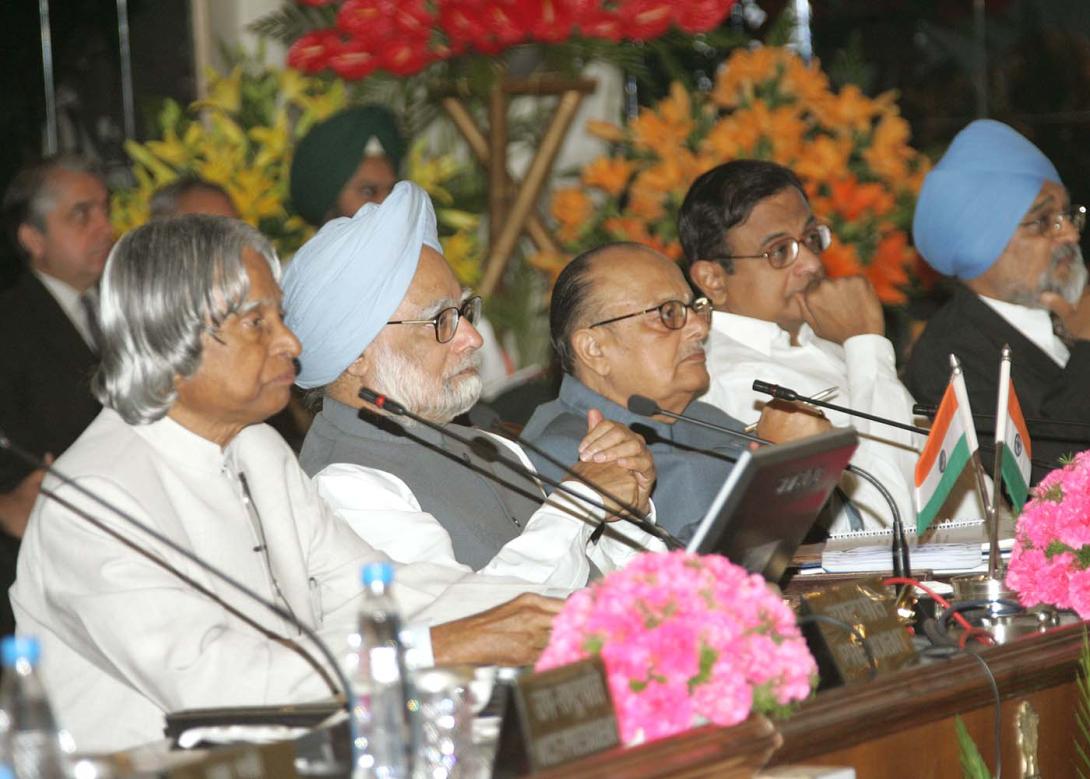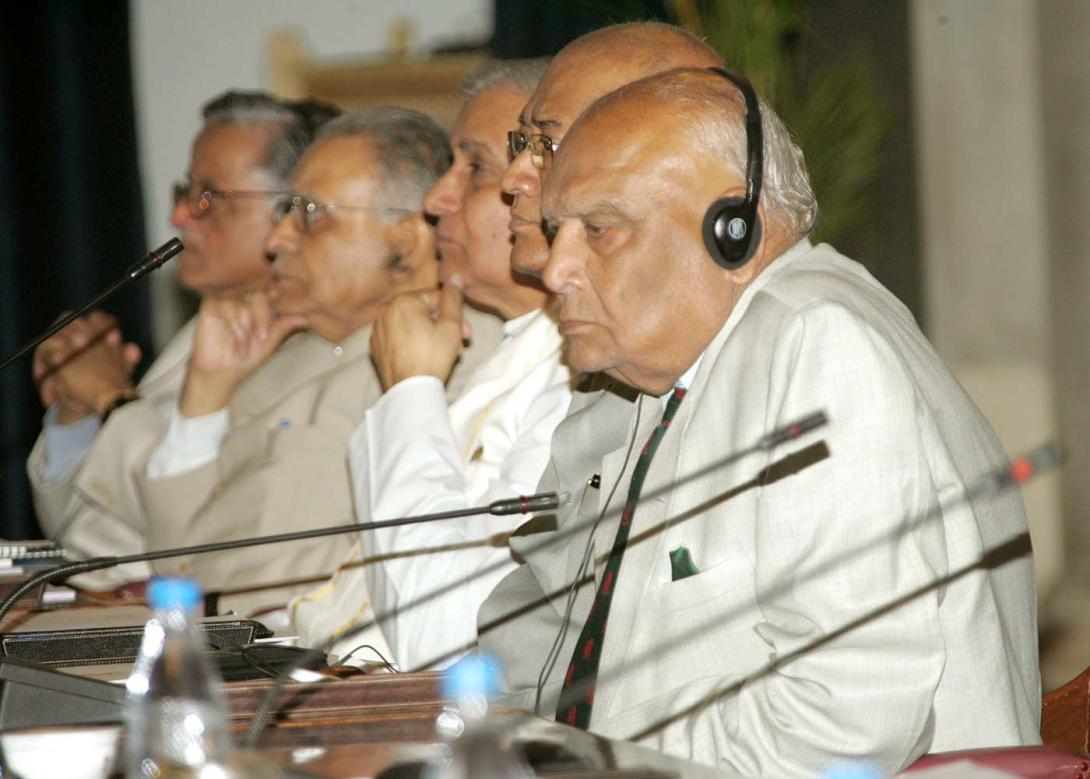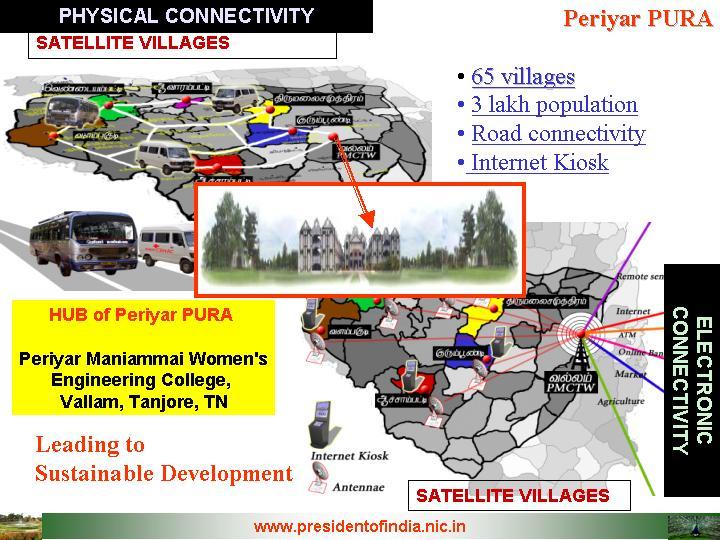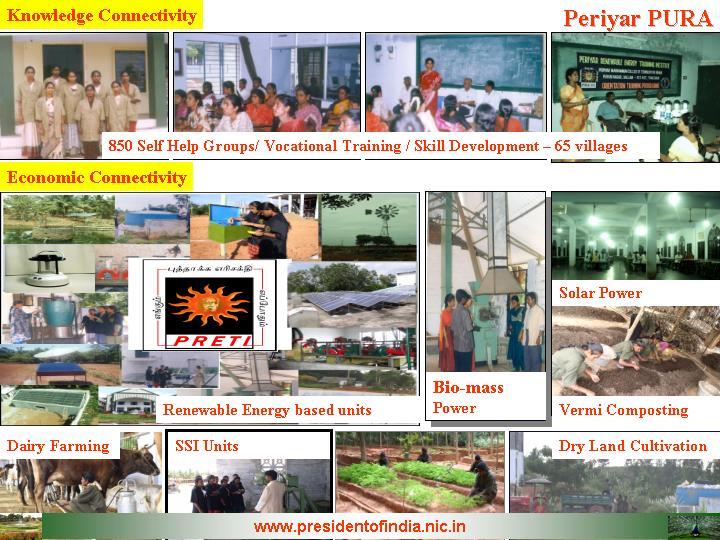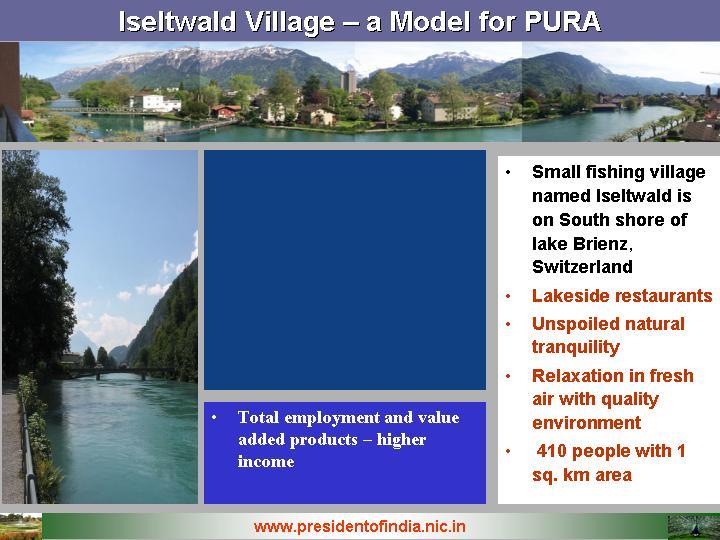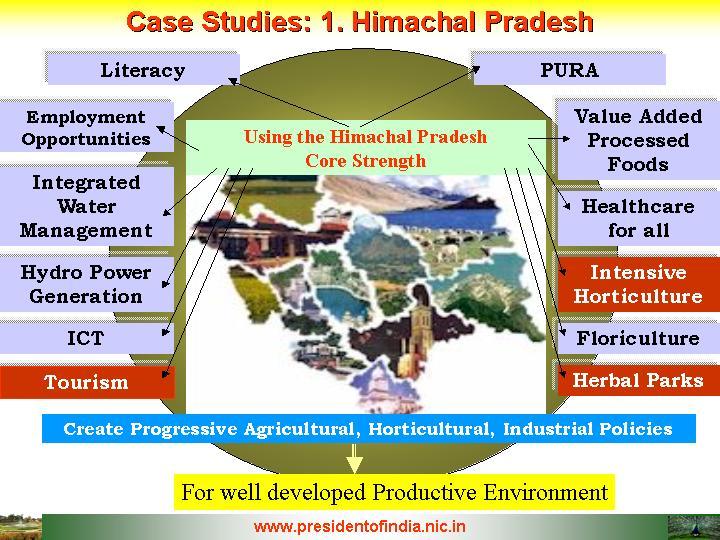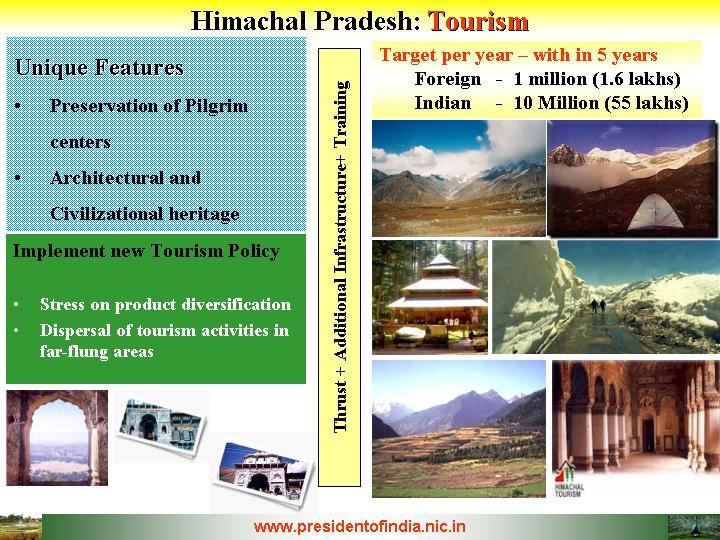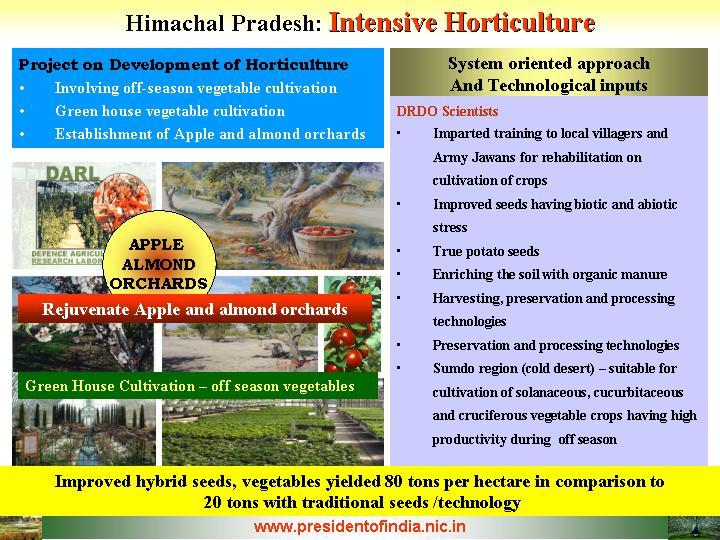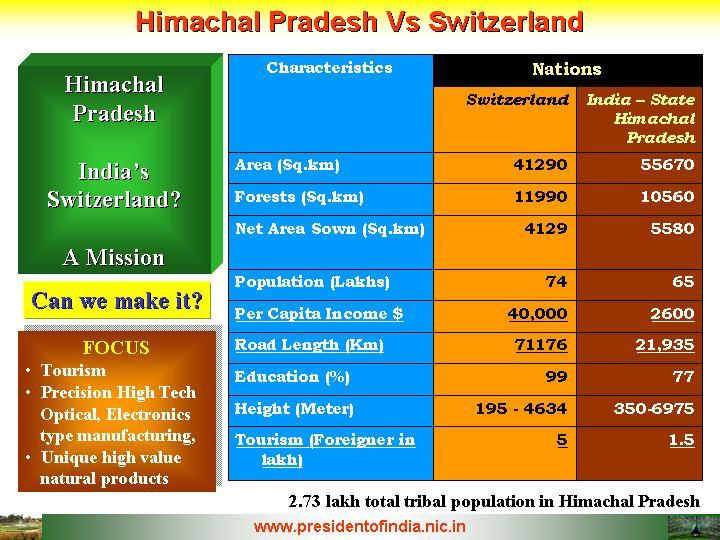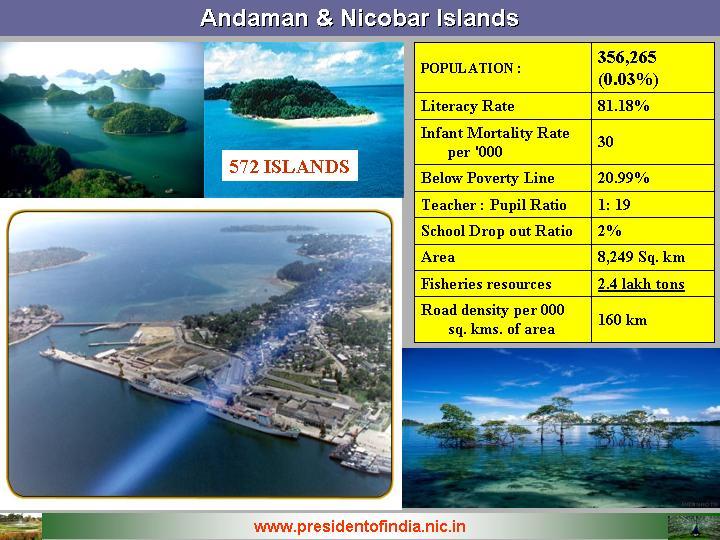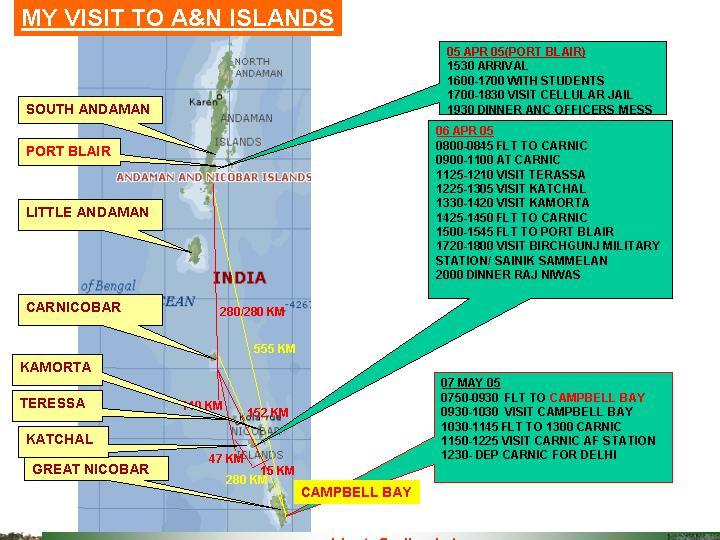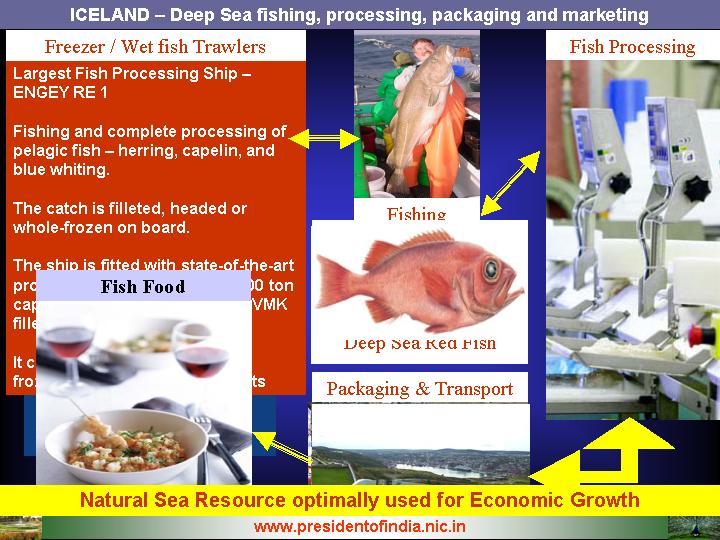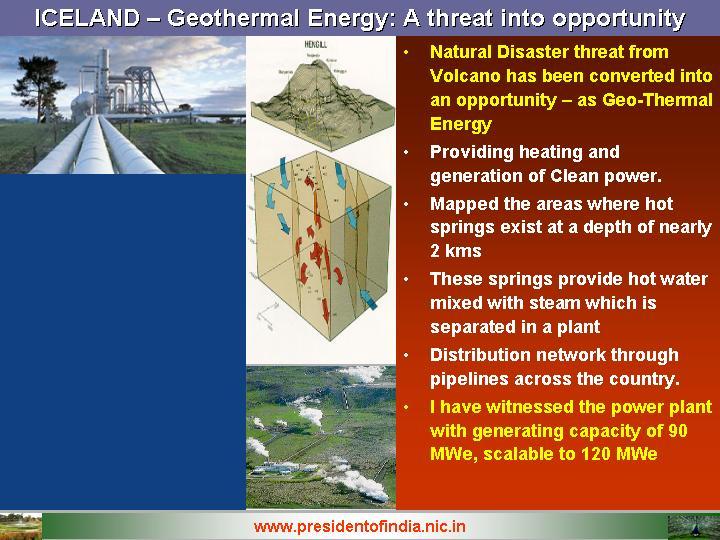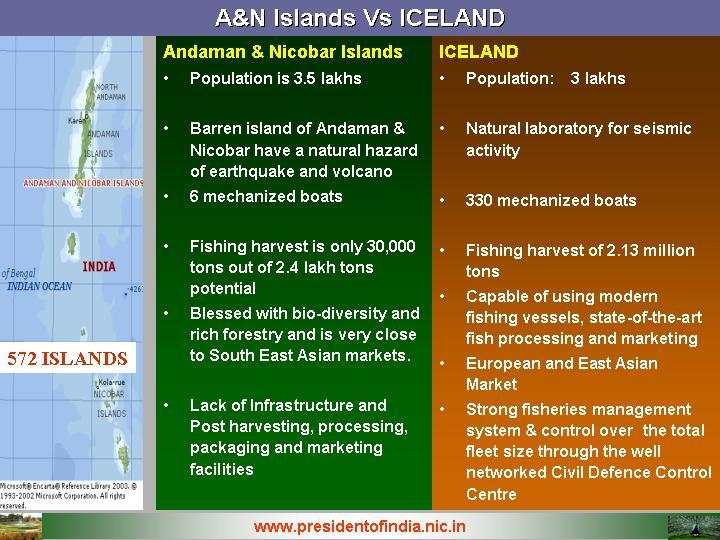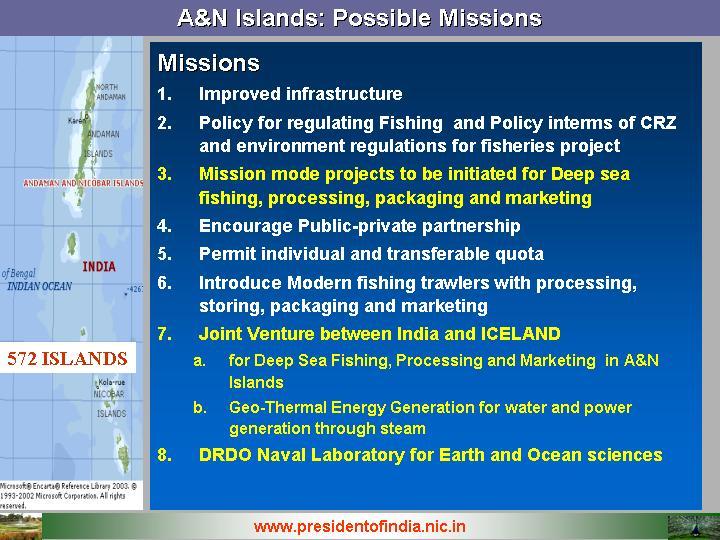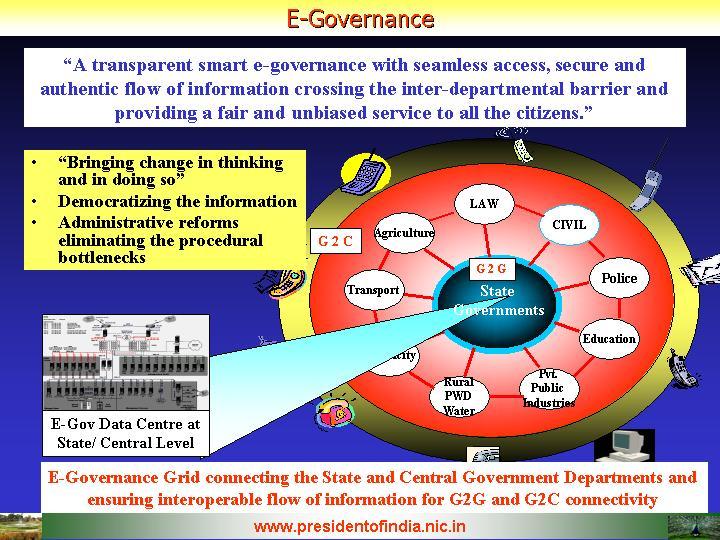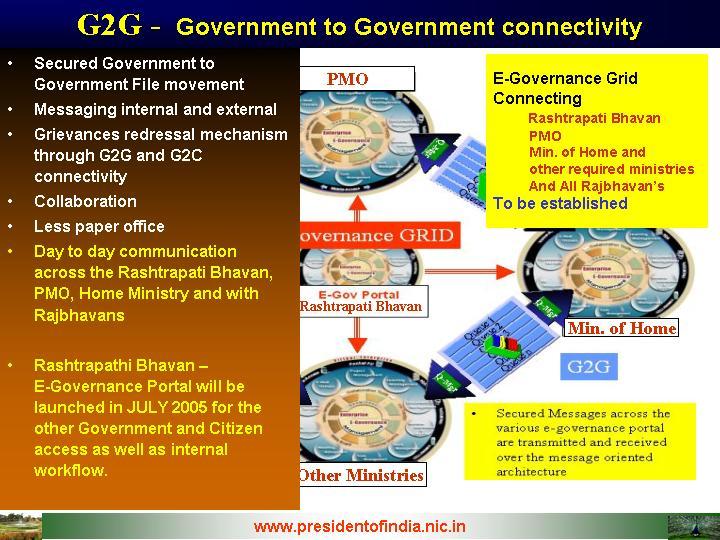Governors Conference - 2005
Rashtrapati Bhavan, New Delhi : 15-06-2005
Dynamics of Development
Hon’ble VicePresident, Hon’ble Prime Minister, Hon’ble Ministers, Hon’ble Deputy Chairman Planning Commission, Hon’ble Governors, Hon’ble Lt. Governors and senior officials. During the last three hours we had an opportunity to hear and interact with the Hon’ble Governors on the development of their States, problems and issues. Now, I would like to discuss on the topic ‘Dynamics of Development’ with this audience who can in one way or the other facilitate the process of achieving the aim of transforming India into a developed nation by the year 2020.
Our National Mission Challenges
Our nation is going through a major challenge of uplifting 260 million people who are below the poverty line and also to give better life for many millions who are on the border line of poverty or just above the poverty line. They need decent habitat, they need work with reasonable income, they need food, they need health care, and they need education and finally resulting into a good life. Our GDP is growing at more than 6% to 7% per annum on an average. Whereas, the economists suggest that to uplift the people from below the poverty line, our economy has to grow at the rate of 10% per annum consistently, for over a decade.
Ambience in the Nation
In the Indian history, very rarely we have come across a situation, all at a time, an ascending economic trajectory, continuously rising foreign exchange reserve, continuously reducing rate of inflation, global recognition of technological competence, energy of 540 million youth, umbilical connectivities of 20 million people of Indian origin in various parts of the planet, and the interest shown by many developed countries to invest in our engineers and scientists including setting up of new R&D centers. As per the report titled “From the Ganges to the Thames” which states that the Indian Foreign Direct Investment in British capital is second only to that of the US and Indian FDI project in Europe has increased from just five to hundred and nineteen during the period 1997 to 2004. The Government is also committed to economic development by ensuring growth rate of 7% to 8% annually, enhancing the welfare of the farmers and workers and unleashing the creativity of the entrepreneurs, business persons, scientists, engineers and others productive forces of the society. Our nation has built a reputation for its democracy and for providing leadership for the one billion people with multiculture, multilanguage and multireligion. And also our technological competence and value system with civilizational heritage has been highly respected. Can we expect anything better than this for increasing the momentum of our development missions? Let us translate this great opportunity for transforming our states into developed states to realize our cherished dream of Developed India before 2020.
Engines for Growth: Emphasis should be on full utilization of natural and human resources of the nation to meet the demands of the modern society. We should also remember that about 50% of our population is young people with aspirations for better living. Value addition to Agriculture, Manufacturing and Service sectors, building the national core competence and technologies will lead to additional high income employment potential. The engines for growth will be accelerated by launching of the five national missions viz. water, energy, education and skills, infrastructure and employment generation that will enable achievement of 10% GDP growth rate per annum. It is possible to do so with ecological and economic sustainability.
Integrated action:To meet the need of one billion people, we have the mission of transforming India into a developed nation. We have identified five areas where India has a core competence for integrated action:
(1) Agriculture and food processing
(2) Reliable and Quality Electric power, Surface transport and Infrastructure for all parts of the country.
(3) Education and Healthcare
(4) Information and Communication Technology
(5) Strategic sectors. These five areas are closely interrelated and if well done would lead to food and economic security and national security.
With these aspects, we have already laid down the road map. The priority for the government is to convert the road map into various missions. While converting the vision into different missions we seem to have many thoughts and variety of routes to reach the goal. This is where there is a need to have a coherent thinking among all the members of the society. All of them need to think that the nation is greater than an individual or an organization. There is a mindset among many that "we cannot do it". However in my experience with many institutions in the country and the observations of the results of some of them in the mission mode projects, I can assure you that whenever we have decided to achieve certain goals with clear targets, we have always achieved it. I have seen this even in private and public sector industries if they decide to take up tasks as a mission, they succeed. Let me discuss the PURA (Providing Urban Amenities in Rural Areas) model with you.
Rural Prosperity through PURA
Providing connectivity to village complexes is an urgent need to bridge the ruralurban divide, generate employment and enhance rural prosperity. Repeating what we did before for several decades with more of the same may not be the way to proceed further. We need to innovate to increase connectivities to the villages making clusters out of them even while retaining their individualities.
Essential Connectivities: The integrated methods which will bring prosperity to rural India are: the physical connectivity of the village clusters through quality roads and transport; electronic connectivity through telecommunication with high bandwidth fiber optic cables reaching the rural areas and also through broadband wireless; knowledge connectivity through education, skill training for farmers, artisans and craftsmen and entrepreneurship programmes. These three connectivities will lead to economic connectivity through starting of enterprises with the help of banks, micro credits and marketing of the products. The integrated method envisages a mission mode empowered management structure with executive powers at the local implementation levels and by reducing the transactional costs through simplification of procedures of governance. Hence, the important element of rural development happens to be PURA.
PURA Enterprise: The Small Scale Industrial sector in the country has experience in managing the small scale industries of different types in various regions. This sector is widely spread in the country and is a promising candidate for becoming the chief and managing the PURA complexes in an integrated way. PURA enterprises can undertake management of schools, health care units, vocational training centres, chilling plants, silos and building a market, banking system and the regional business or industrial units. A new management style has to emerge for managing such type of PURA enterprises. This new PURA enterprise needs partnership from the bank, from the Government, from NGOs and also from the private entrepreneurs.
Structural Support for PURA: Government, NGOs and Corporate sector can be a facilitator for creating this entrepreneurship scheme through the support of the banking system and the marketing system under the cooperative development model. Entrepreneurs and the corporate sector should identify the PURA complexes in their areas and adopt them, so that they can be developed in an integrated way. They should create an integrated plan of entrepreneurship development, skill development, product development and establishing market. Determination of products should be done on the basis of the core competence of the region, the availability of raw materials and infrastructure. Once the product is determined it will also involve infusion of new technologies for making it attractive for both national and international market and also productivity enhancement. After establishing the process and methods a vocational training package needs to be established for improving the skill sets of the local population. This is also the time for developing entrepreneurs with leadership qualities who will then create and nurture the enterprise. The selection of entrepreneurs should be preferably done from the higher educational institutions in the region. This will enable creation of the village level industries simultaneously with the establishment of connectivities in the region.
Each PURA depending upon the region will cost between Rs.50100 crores. It has to provide direct employment opportunity for 3000 people in a complex having 30000 population. This will also generate employment opportunities in service and support sector for about 10000 people. If we create smallscale enterprises, this will mean creation of approximately 1020 enterprises per PURA complex having an average employee strength of 150. This will reduce the employment gap in rural areas and lead to the upliftment of the 260 million people living below the poverty line.
Bharat Nirman Programme
The Union Government has conceived of Bharat Nirman as a fouryear business plan for building infrastructure, especially in rural India. It will have six components, namely, irrigation, roads; water supply, housing, rural electrification and rural telecom connectivity. The broad goals of Bharat Nirman would be:
bringing an additional 10 million ha of land under assured irrigation
providing roadconnectivity to all villages having a population of 1000 (or 500 in hilly/tribal areas)
constructing 60 lakh additional houses for the poor
providing drinking water to the remaining 74,000 habitations that are uncovered
reaching electricity to the remaining 1,25,000 villages and electricity connections to 2.3 crore households
Providing telephone connectivity to the remaining 66,822 villages.
The programme, which had been estimated to cost Rs 1,74,000 crore (Rs 1740 billion) over the next five years. The government has allocated an additional Rs 25,000 crore (Rs 250 billion) for social sector programmes during the current financial year. Bharat Nirman will involve Panchayati Raj Institutions in its planning and implementation.
Visions and Missions
I have visited almost all the States and Union Territories of our Republic. This provided me an opportunity to meet a wide cross sections of people, particularly rural citizens and youth. The State Legislative Assemblies of Andhra Pradesh, Bihar, Chattisgarh, Himachal Pradesh, Jammu & Kashmir, Jharkhand and Pondicherry invited me to speak. I also visited nine countries during my three visits abroad. I would like to present my analysis about the development potential and the dynamics of development in the light of my experiences during these interactions.
I would like the Governors to discuss about how we can make India prosperous and become developed India by 2020. I would like to present the development models based on PURA in India and also the development models in the counties that I have visited such as Switzerland and Iceland. Can we use these experiences to develop a focused approach for making every state a developed state? My aim is also to present a case study of Himachal Pradesh and Andaman Nicobar Islands.
Though the case studies seem to be referring to only two states, the approach is indeed applicable to all the states in India. We have natural resources, human resources and investment potential. Every state should aim at, minimum 10% GDP growth. Then only we will achieve consistent growth rate. A good roadmap, good leaders and a transparent way of management and administration are the need of the hour.
Periyar PURA
Recently I had visited Periyar Maniammai college of technology for women and inaugurated a PURA Complex. I thought of sharing with you the developmental concept of a cluster of over 65 villages near Vallam, Thanjavur district of Tamilnadu which involves a population of 3 lakhs. This PURA complex has all the three connectivities physical, electronic and knowledge leading to economic connectivity. The centre of activity emanates from the women engineering college that provides the electronic and knowledge connectivity. Periyar PURA has health care centres, primary to post graduate level education and vocational training centres. This has resulted in large scale employment generation and creation of number of entrepreneurs with the active support of 850 selfhelp groups. Two hundreds acres of waste land has been developed into cultivable land with innovative water management schemes such as contour ponds and water sheds for storing and irrigating the fields. All the villagers are busy in either cultivation, planting Jatropha, herbal and medicinal plants, power generation using biomass, food processing and above all running marketing centres. This model has emanated independent of any government initiative. The committed leadership has been provided by the Engineering institution.
This gives me the confidence that PURA is a realizable proposition and this movement can be multiplied by thousands of entrepreneurs, educational administrators and philanthropic institutions with the support of the government agencies.
The model I have discussed gives the confidence that the rural prosperity is certainly possible if we empower the people and empower the organisation and facilitate them by removing the bottlenecks towards the goal of development for the societal transformation.
Iseltwald Village in Switzerland ? a PURA like model
I visited a small fishing village named Iseltwald in Switzerland. It is on South shore of lake Brienz. It is a well known fishing village with popular lake side restaurants. It has unspoiled nature tranquility and relaxation in fresh air with quality environment. It can be accessed by road and waterways. It has a total population of 410 people and an area of approximately one square kilometers. The main enterprise of the village is tourism and fishing. They have got a school and playgrounds in the centre of the village. The people in the village are employed in looking after the tourists and running hotels, fishing, working in vineyards and breweries. 5 to 10% of the people go to neighbouring towns for employment. Total employment and the value added products provide higher income to all the residents of the village. This leads to higher standard of living which is equivalent to staying in any one of the cities and also the availability of facilities through connectivity so that the villagers remain in their villages without migrating to cities. Education facilities, healthcare centres and employment opportunities are all available within the village itself like what we envisage in the PURA.
It is possible for us to replicate this in all the villages of Himachal Pradesh by providing physical, electronic and knowledge connectivities and thereby economic connectivity. In essence if we can provide physical connectivity (land, air and water), provide quality service to the tourist and give him the confidence of secure and serene atmosphere he is a happy tourist and will time and again come to the same place to spend his vacations. Also he carries the message to his friends and relatives about the goodness of the place which indirectly becomes an advertisement for the tourism value of the village. Can we create Iseltwald villages in Himachal Pradesh and Jammu and Kashmir and some of our North Eastern states?
A Case Study: Himachal Pradesh and Switzerland
Himachal is blessed with bounty of the Himalayas, five perennial rivers, string of lakes, snow peaks, ancient shrin
and brave people. Himachal is also a home to many a rare species of birds, animals and plants. We have to collectively see how we can utilize these blessings of nature for the betterment of the lives of the people of Himachal and colive. When I addressed, Himachal Pradesh State Legislative assembly, we have discussed about 9 missions. These are Literacy, Skills, Education and Health Care, Providing Urban Amenities to Rural Areas (PURA), Medicinal, Floriculture and Aromatic Plants, Intensive horticulture, Integrated Water Resource Management, hydro power generation, Information and Communication Technologies (ICT), Tourism, and Valueadded Garment Industry. I would like to discuss some of these missions.
From my recent visit to Switzerland I am convinced our country has all the resources both human and physical for making the nation rich. For example when I study Switzerland in relation to our hill state Himachal Pradesh, I find close comparison between land area, forests, population and the terrain, one close to the Alps and the other close to the Himalayas. Leading particulars of Switzerland and HP are given in the table. The population of Switzerland and Himachal Pradesh are 75 lakhs and 65 lakhs respectively, whereas, the per capital GDP of Switzerland is $ 40 thousand and that of Himachal Pradesh is $ 2600 . One of the key differences between Himachal Pradesh and Switzerland is that we have only 21 thousand kilometers of road whereas Switzerland has 77 thousand kms of road with large number of tunnels to cut down the distance to be traveled and the time. This physical connectivity makes a big difference in the economic activity of the state.
Comparative Table (Switzerland and Himachal Pradesh)
A Case Study: Andaman & Nicobar Islands and Iceland
A case study of Andaman & Nicobar Islands and Iceland brings out the land area of Andaman Nicobar is about 8% of the land area of Iceland, whereas Iceland has a population of 3 lakhs and the population of Andaman & Nicobar is 3.5 lakhs. The territorial area of both Iceland and Andaman & Nicobar Island is 12 nautical miles. Barren island of Andaman & Nicobar and Iceland have a natural hazard of earthquake and volcano.
Both have been blessed with sea on all the sides and marines resources. Andaman Nicobar particularly is blessed with biodiversity and rich forestry and is very close to South East Asian markets. Iceland is getting 2.13 million tons of fish every year whereas the fishing harvest of Andaman Nicobar islands is thirty thousand tons. Large scale fishing has become possible for them mainly due to possession of large mechanized boats numbering 330, whereas Andaman & Nicobar has just 6 mechanized boats. Also, the population in Iceland is the sea faring population of 2.9 lakhs capable of using modern fishing vessels, stateofthefish processing and marketing industry for servicing the European markets. They have a strong fisheries management system and control over the total fleet size through the well networked Civil Defence Control Centre. They have an annual quota system for individuals based upon total allowable catch.
In addition to the above Iceland has converted their threat from the volcano into an opportunity for providing heating and generation of unpolluted power. They have mapped the areas where hot springs exist at a depth of nearly 2 kms. These springs provide hot water mixed with steam which is separated in a plant. The hot water is taken to the cities on insulated pipelines for providing heating to the houses
and the steam is taken to the turbines for generation of electricity. I saw a cluster of plants which had a generating capacity of 90 MWe. They are planning future geothermal electric plants of the size of 120 MWe. This utilisation of hot spring water also provides a natural bleeding for the system reducing the possibility of further volcanoes in the same region. In addition to these two areas which are the core strengths of Iceland they have diversified into Pharma industries and hydrogen fuel buses. Also they are making selective investments in different countries. The percapita GDP of Iceland is $ 31,900.
Can we study the possibility of converting the volcanic barren island for generating electricity which can be useful for the entire Andaman & Nicobar islands? Also, can we adopt the mechanized deep water fishing, fish processing, storage and marketing to enhance our growth in this sector by at least four times within the next four years. In addition the island will need tourism infrastructure both internal and external, through roadways, waterways and airways. Some of the vacant islands can be made into an integrated tourist destinations with infrastructure built through leasing of certain areas to reputed Build Own and Operate Companies on the lines of Maldives. The combined effect of improving the fishing, production of electricity from geothermal sources and proactive tourism can definitely generate wealth for the island and double the per capita GDP of the state within the next 3 to 4 years.
How do we realize the mission
We should recognize the core competence of each one of the states and build around it as in the case of Andaman Nicobar Islands or Himachal Pradesh. We should develop PURAs as a growth vehicle around which the enterprise such as fishing enterprise or a tourism enterprise is built and managed. Today, as part of the Bharat Nirman Programme funds are available for providing connectivity, housing, drinking water supply, electrification, drainage scheme for all the villages. We have to take an integrated action to make the facilities available to selected village complexes in a time bound manner, so that these clusters can become revenue generating businesses. Later the revenue coming from these clusters can also be ploughed back for creating enterprises in different areas due to the confidence generated among the entrepreneurs about the viability of PURA enterprises. What we need is a bold, uninterrupted, integrated action by all sectors of the economy to make the whole concept viable. It will require partnership from entrepreneurs, banks, academy, NGOs and government to make the entire scheme successful.
EGovernance An important indicator of development of any nation is the transparency associated with the governance. The eGovernance provides an avenue for making the Governmental transactions, be it Government to Government (G2G) or Government to Citizen (G2C) completely transparent.
EGovernance will also ensure that the development reaches the people and brings prosperity. The ICT plays a crucial role in the implementation of eGovernance.
It can be said that eGovernance is :
"A transparent smart egovernance with seamless access, secure and authentic flow of information crossing the interdepartmental barrier and providing a fair and unbiased service to all the citizens."
Two years back, we undertook an exercise to completely automate the transactions of the Rashtrapati Bhavan both G2G and G2C and introduce eGovernance. Today, I am very happy to inform you that due to the concentrated work of my colleagues at Rashtrapati Bhavan we have a fully functional and automated system for information and workflow of varying levels of secrecy ? for example highly secret communication from the PMO and/or any Government Department to President?s Office to very simple day to day letters and messages from the citizens. The software is currently undergoing field trails. We would be launching a fully tested and validated user friendly software by the last week of July 2005. At the first instance, we would be happy to share this software with Raj Bhavans, PMO and Home Ministry and can be customized to suite their requirements. By this the Raj Bhavans can also take advantage of the secure and assured connectivity between Rashtrapati Bhavan, PMO and the Home Ministry. I visualize the interactions and communications between us will take place through this egovernance Grid very soon.
Conclusion
In conclusion, I would like to talk to you about the linkage and powering components between national economic development and Creative Leadership.
Nations Economic development is powered by competitiveness.
The competitiveness is powered by knowledge power.
The knowledge power is powered by Technology and innovation.
The Technology and innovation is powered by resource investment.
The Resource investment is powered by revenue and return on Investment.
The Revenue is powered by Volume and repeat sales through customer loyalty.
The customer loyalty is powered by Quality and value of products.
Quality and value of products is powered by Employee Productivity and innovation.
The Employee Productivity is powered by Employee Loyalty, employee satisfaction and working environment.
The Working Environment is powered by management stewardship and sound project management.
Finally the management stewardship is powered by Creative leadership.
This makes me recall the saintly saying of Maha Rishi Patanjali in Yoga SUTHRAS: ?When you are inspired by some great purpose, some extraordinary task, all your thoughts break their bounds: Your mind transcends limitations, your consciousness expands in every direction, and you find yourself in a new, great, and wonderful world. Dormant forces, faculties and talents become alive, and you discover yourself to be a greater person by far than you ever dreamed yourself to be?.
My best wishes to the Hon?ble Governors in their mission of making their states developed and prosperous.
May God bless you!

